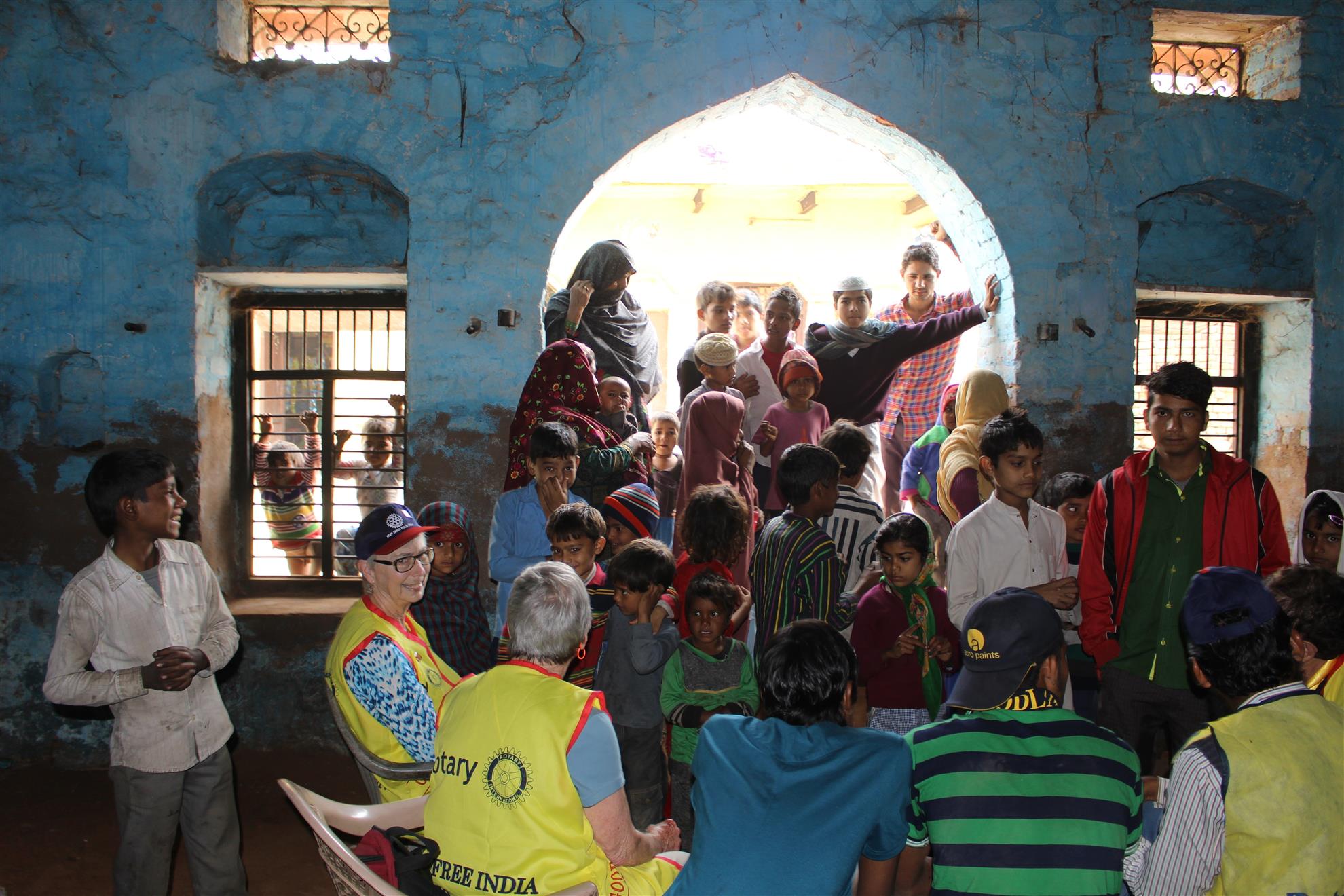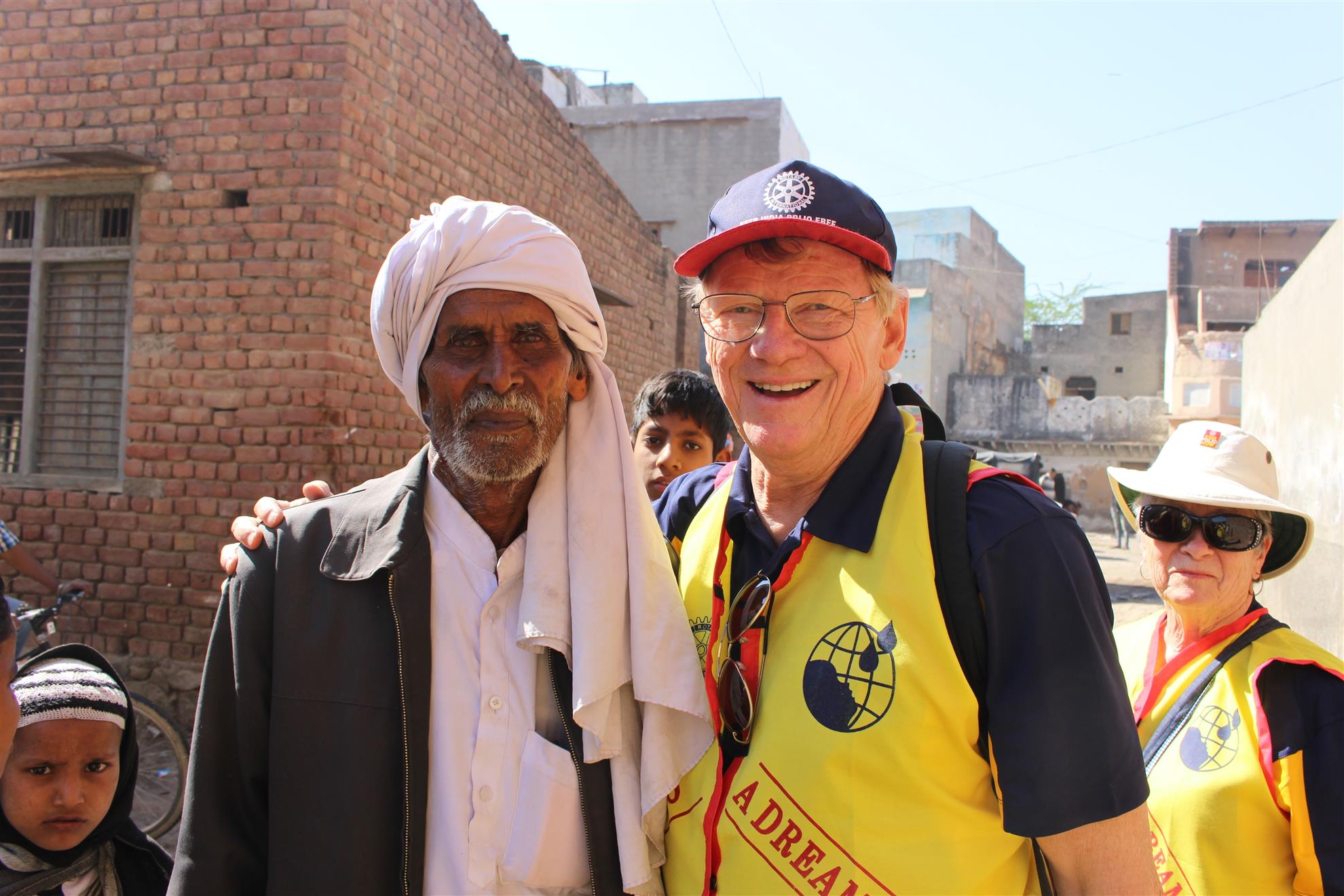Rotarians Working to Eliminate Polio: A Personal Account of an Extraordinary Trip
Posted by Peter Anderson
My wife Elena and I have always had a moderate interest in visiting India, but never a strong enough interest to plan a trip.
Then an opportunity came along to travel in relative comfort (western-style hotels and our own guide and bus driver) and with a bunch of really good people (Rotarians). It worked out great. We spent two weeks in India in February on a two-part visit: Tourism and Polio.
A few words that I can use to summarize my impressions of the country: HUGE, ENERGETIC, HISTORIC, CONTRASTS, TOLERANT.
Three and a half times as many people live in India as we have in the US (1.3 billion); all live within an area half the size of the continental US. [HUGE!] And every person we saw was hustling to accomplish something, whether pushing a vegetable cart barefoot or driving a Mercedes in a three-piece suit. [CONTRAST, ENERGETIC]
The Taj Mahal is even more beautiful - incomparable, stunning and glisteningly elegant - than it shows in pictures. Worthy to be called the 8th wonder of the world. Almost 500 years old, in a city 2000 years old. [HISTORIC]. But a city where half of the population lives together peacefully on a dollar a day. [TOLERANT, CONTRASTS]
Our Group: 32 Rotarians from all over the US, plus 6 from Canada and 2 from Australia; ages 20 to 80, mostly between 50 and 60.
Our Purpose: Participate in India’s National Immunization Day (“NID”). (Actually a multi-day NID). We joined the roughly 2½ million paid professional health workers and social workers from all levels of the India government in their task of immunizing roughly 170 million children below the age of 5 against the poliomyelitis virus. All in two days. Read those numbers again: they are HUGE!
The Experience: In a word just MARVELOUS! We worked with the Indians in small groups (usually 4), and even though we frequently struggled with language, we communicated very clearly on the task at hand. My specific group was assigned to a very poor Moslem neighborhood in the village of Mewat, an hour south of Delhi.
On our first day we met our health worker, bringing his invaluable blue box (cooler) containing the polio vaccine, and we set about putting two drops into the mouth of every young child brought to us.
We set up our “vaccination station” in a dusty, dirt-floored, single-story, mud building with only the light that came through the unhinged doorway.

Outside of the vaccination station.
Shy, veiled, mothers brought their infants to this abandoned house, and hesitantly held them out for a pair of white hands to squeeze the drops into reluctant, often terrified mouths. Sometimes it was a teenage sister who came with the infant. But in all truth, we could never tell if she was the sister or the mother. After being vaccinated, the child was marked with indelible indigo ink on the left pinky finger.
We were a spectacle in the neighborhood, since, besides being generally white and wearing our yellow Rotary vests, we arrived in clean clothes and wearing shoes. This was good. We wanted people to know we were there, and to bring us their infants. I increased the attraction level by taking digital photos of young children who happened by, and then showing them what they looked like in the viewfinder. Word got out, and more people came with their infant children.

The inside of our "vaccination station" - a currently
abandoned old house, where mothers brought
their infant children to receive the 2 drops of polio vaccine.
But I soon changed my tactic. I would photograph only children who could show me their indigo pinky finger or would bring me a child with an indigo pinky. That changed their incentive and got us more infants.
On our second day, we followed our health worker, this time with a social worker, who together led us on foot through the neighborhood, house-to-house, seeking those infants not yet vaccinated. On pathways and passageways too narrow for vehicles, we passed intrigued pedestrians and an occasional goat or docile cow. Cows are believed sacred to the Hindu and wander freely, untethered; minority Moslem groups generally acquiesce to the Hindu belief and respect the cow out of custom.
Accompanied by Indian professionals, we comfortably entered Moslem compounds usually prohibited to men, especially to non-believers, and proceeded with our mission unobstructed. At one such house, the young mother held out to me a squirming, screaming infant who was dead set against anything foreign entering his mouth. After squeezing the cheeks, depressing the chin, lifting the forehead, and using all the other techniques taught us, my drops still missed the writhing target three times in a row. And the infant spit out my accurate fourth try. Frustrated, I stood back a moment. That immediately caused the mother to look up with a fearful glimpse that begged me not to give up.
Previously we had been told of a mother in Delhi who, the year before, didn’t want to interrupt her daughter’s nap to have her vaccinated. Less than a month later, the infant girl was paralyzed by the disease. We were not to give up on our vaccination mission.


A Rotarian from the Rotary Club of Livermore
preparing to give the 2 drops, while another
prepares to mark the pinky finger of the inoculated.
The village mother knew absolutely nothing about me, other than that I was from a different race, country, culture, and religion – the kind of person railed against by religious leaders as untrustworthy and threatening. But I was wearing the bright yellow Rotary vest, standing alongside a Hindu Indian. That was good enough for her.

Peter with the government of India Community
Health worker, with whom we worked in vaccinating
infants in our assigned village of Mewat,
about an hour south of Delhi.
She thrust her baby up at me again, and together we got the next two drops into the reluctant mouth. Once sure that the drops were swallowed, she slowly raised her head and unabashedly exposed her entire, unveiled face to me, something Moslem women are forbidden to do. We shared a smile of satisfaction that together we got the job done. But more than that; I saw the smile of her gratitude that I cared enough to persevere to make sure that her child was protected. And it was clear to me that the health of her baby was more important to her than any cultural or religious protocol. At least for that moment, anyway. The image of that smile is burned into my memory forever.
Would I ever do this again? In a heartbeat.